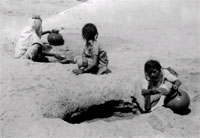Water weary
Water weary

water scarcity seems to be a perennial problem in the remote villages of Gujarat. In Nanimorsal - a village in Sayla taluka of Surendranagar district of the state - drinking water is scarce throughout the year. The problem is accentuated in summer. Groundwater has depleted due to the extraction of water for irrigation.
Every day people, especially women, spend six to seven hours collecting drinking water. People who have bullock carts go to Nanakandasar village, which is five km away. A majority of the families are dependant on the small pits dug in the river bed called 'virda'. In winter, water is available at a depth of 4-5 feet, while in summer it recedes to 10 feet, beyond which there is hard rock.
It takes nearly two hours to collect 5-6 litres of water from a virda. As such, women have to wait for nearly six hours to fill two pots for their daily requirement of water.In addition, they have to wait for nearly 5-6 hours for their turn to collect water. The women thus spend 10-12 hours a day collecting drinking water.
There are many more villages like Nanimorsal in the area, where women spend 10-12 hours every day to collect drinking water. But they can hardly afford to waste so much time as they also have to cook, take care of animals and clean the house. While drinking water is an issue that needs to be addressed immediately, lack of even adequate water for bathing poses a serious health hazard. Most people are in a position to bathe only once every 8-10 days.
In many places like Jasapar, dams have been built near the villages but the water is provided for irrigation and not for drinking. In addition, water from these dams is supplied to far off towns, rather than villages nearby. The Aga Khan Rural Support Programme, an ngo working in the area, is planning to construct underground check dams in these areas to improve the subsoil water table. Construction of roof rainwater harvesting structures is another option for the conservation of water.







